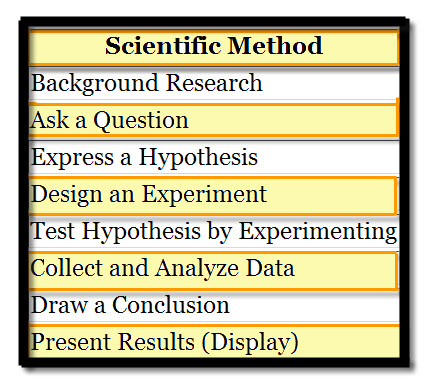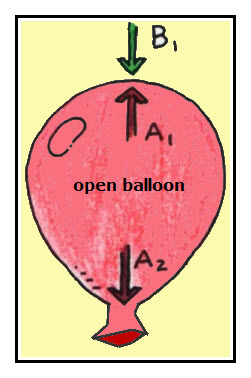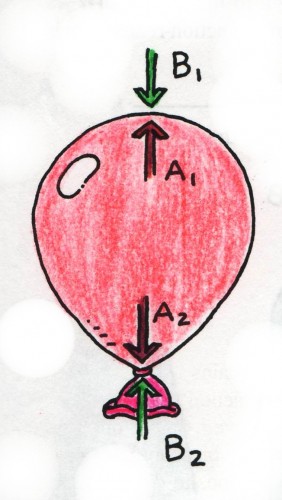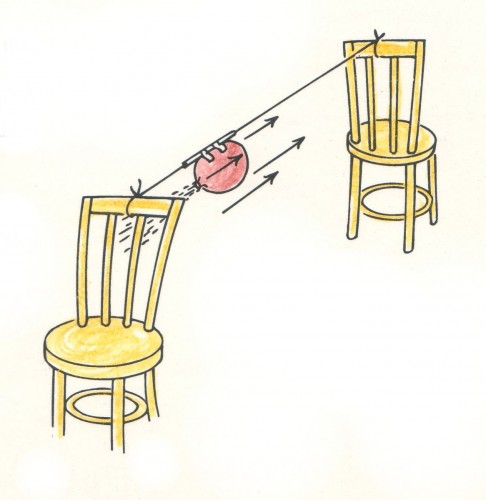 Science Fair Project
Science Fair Project
Category: Astrophysics
Topic: Balloon Rocket
Introduction
The development of the science fair project described in this booklet can be used for any 6th through 12th grade student. This is because the basic process is the same no matter what grade you are in. The difference is in the complexity of the project. In addition to assistance from your teacher, you can determine the complexity required by researching science fair projects developed by other students at your grade level.
The diagram has a suggested list to follow when developing a science fair project. These steps are called the Scientific Method. Please know that while all of the steps are important and there is some required order, such as writing the conclusion after you have completed the investigation. But, you are not bound by the order.
This guide provides ideas and suggestions, but not a step-by-step procedure for developing a science fair problem. While you have purchased a kit, you will not clone the ideas of the kit’s author; instead you will use the materials and clues provided to design your own product. The materials provided are basic. You may have to secure other items as well as adult assistance, but you want to be the engineer-you want to be the inventor.–you want to be the science investigator. In other words, you want to maintain ownership of the project. To do this, you must be in charge of the design, development, testing, and final presentation of the project.
How to Get Started!
1. Decide on a topic.
You accomplished this objective by selecting this Engineering Kit. Your topic is BALLOON ROCKETS.
2. Research the Topic
Secondary Research: This is information in print. Generally it is the first type of research that you will do. Some secondary research is included in this guide. Study it first, and then use other sources. Make a point to use updated sources. Online information from colleges and university as well as well known published authors are generally trustworthy.
It is helpful to read about engineering projects on your topic, especially if they have won prizes. This is not a suggestion to clone the ideas of others. Instead, it will reveal to you how complex the project must be. Too often students have the misguided idea that they must design the next space shuttle. Reading about successful projects will also let you know that award winning engineering projects do not require expensive materials or equipment.
A bibliography should be part of your report.
Primary Research: This is information you collect on your own. This includes information from exploratory experiments you perform and interviews you make.
An exploratory experiment is the foundation of the balloon rocket project in this kit. This is listed with the research.
3. Identify the purpose of your project.
Secondary Research
Newton’s third law is often summarized as “Action-Reaction” forces. In other words, this law compares forces that act in pairs. A simple explanation of this law is that an Action Force results in a Reaction Force.
Characteristics of Action/Reaction Forces
1. The two forces are equal in magnitude.
2. ?The two forces are in opposite directions.
3. It is important to remember that the action force is applied to an object, and the reaction force is applied to something else.
4. The reverse description of one force describes the other force.
- In the closed balloon diagram, all the forces are of equal magnitude.
- A1 and A2 represent the forces of the gas inside the closed balloon pushing out on the balloon’s rubber membrane.
- B1 and B2 represent the force of the balloon’s rubber membrane pushing inward on the gas.
Description of the Two Pairs of Action/Reaction Represented by The Diagram
Pair 1: A1/B1
Force A1:
The gas inside the balloon pushes outward on the balloon’s rubber membrane.
Force B1:
The balloon’s rubber membrane pushes inward on the gas inside the balloon.
Pair 2: A2/B2
Force A2:
The gas inside the balloon pushes outward on the balloon’s rubber membrane.
Force B2:
The balloon’s rubber membrane pushes inward on the gas inside the balloon.
Balanced Forces
Pairs of balanced forces have some similar characteristics as a pair of action/reaction forces, such as having the same magnitude and acting in opposite directions.
An important difference between a pair of balanced forces and a pair of action/reaction forces is that each force acts on the same surface.
The balanced pairs of forces shown for the close inflated balloon are A1/A2 and B1/B2.
Balanced Pair of Forces: A1/A2
The gas forces inside the closed balloon, A1 and A2 are balanced. These forces are equal in magnitude and push in opposite directions on the balloon’s rubber surface
Balanced Pair of Forces: B1/B2T
The forces of the balloon’s rubber surface, B1 and B2 are balanced. These two forces are equal in magnitude and push in opposite directions on the gas inside the closed balloon.
Unbalanced Forces
An unbal anced force doesn’t have a partner force of equal magnitude in an opposite direction.
anced force doesn’t have a partner force of equal magnitude in an opposite direction.
An unbalanced force causes the material it acts on to accelerate, which means to move at a faster and faster speed in the direction of the unbalanced force.
With the mouth of the balloon open, A2 represent the force of gas inside the balloon directed toward the balloon’s open mouth. While the air outside the balloon does push against the escaping gas, the force of A2 is greater, so the gas accelerates as it moves out the opening.
A1 is also an unbalanced force that causes the balloon to accelerate upward. Remember: Balanced forces are equal in magnitude, push against the same surface but in opposite directions. Thus, A1 and B1 are not a pair of balanced forces.
Did You Know?
A common error in describing why rockets blast off is that the gas exhaust pushes against the surface beneath the rocket, and this surfaces pushes back on the rocket lifting it.
The gas of the rocket, like the gas exiting the balloon does not lift the rocket or the balloon. In fact, if anything, the gas exhaust hinders the lift off.
Primary Research
Purpose: To investigate the construction and movement of a balloon rocket.
Materials
6 feet (1.8 m) of string
4-inch (10-cm) piece of drinking straw
9-inch (23-cm) round balloon
2 chairs
spring clothespin
transparent tape
Procedure
1. Thread the string through the straw.
2. Tie the ends of the string to the backs of the chairs.
3. Position the chairs so that the string between them is as tight as possible.
4. Inflate the balloon. Twist the open end of the balloon and secure it with the clothespin.
5. Move the straw to one end of the string.
6. Tape the inflated balloon to the straw.
7. Remove the clothespin from the balloon.
Results The straw with the attached balloon quickly moves across the string. The movement stops at the end of the string or when the balloon is totally deflated.
Challenges:
A science fair project should be a cause and effect investigation. This means that you are going to determine how a specific condition causes something to change. Things in an investigation that can change are called variables.
In a science fair project you want two things to change, thus you need two types of variables; an independent variable and a dependent variable. Changes in the independent variable are expected to cause changes in the dependent variable.
Controlled Variables are all the things that could affect experimental results, such as amount of air in the balloon, type, shape, or size of the balloon, type, shape and size of the straw, and type of string used. Note: Any one of the variables listed could be used as the independent variable.
Use the Balloon Rocket Exploratory Experiment as your control experiment. This experiment is what you use as your standard. This means that you change the control someway and compare the new experimental results with the control.
1. How does the shape of the balloon affect the speed of the balloon rocket?
Independent variable = balloon shape
Dependent variable= speed of the balloon
2. How does the size of the balloon affect the speed of the balloon rocket?
Independent variable = balloon size
Dependent variable= speed of the balloon
3. How does the size of the straw affect the speed of the balloon rocket?
Independent variable = straw size
Dependent variable= speed of the balloon
4. How does the type of string affect the speed of the balloon rocket?
Independent variable = balloon shape
Dependent variable= speed of the balloon
 |
Janice VanCleave’s Guide to More of the Best Science Fair Projects |

